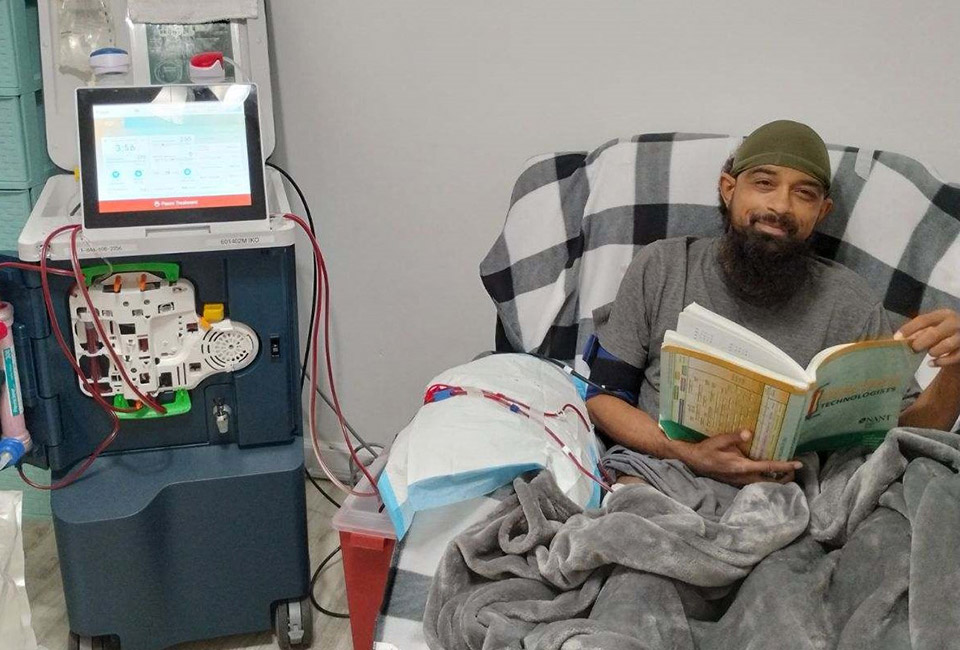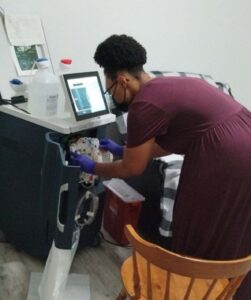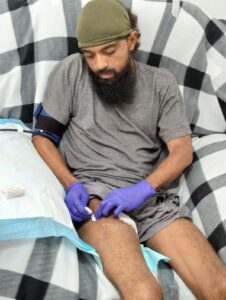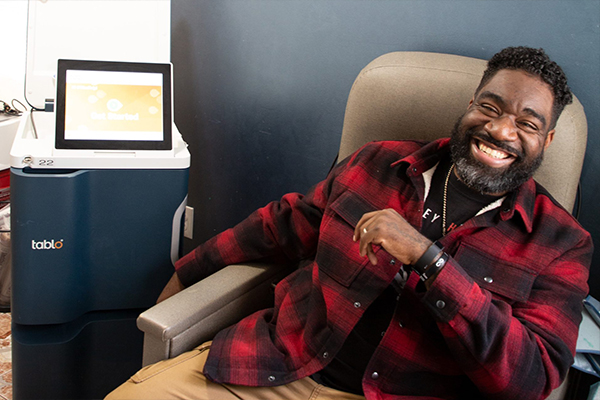Standing Up to Hereditary Kidney Disease with Home Dialysis: Rapa’s Story

Summary
Rapa’s challenging 25-year kidney disease journey has included Alport Syndrome, three kidney transplants and every kind of dialysis and vascular access. Now, he hopes to inspire other kidney disease patients to experience the autonomy and control of home dialysis with Tablo.
Rapa, now in his thirties, began his kidney disease journey when he was born with Alport Syndrome (AS). AS is a rare, inherited, progressive disease that damages blood vessels in the glomeruli of the kidneys. The condition, that his mother also had, can lead to kidney disease and eventual end-stage kidney disease (ESKD; also known as end-stage renal disease, or ESRD), along with hearing loss and eye abnormalities. Rapa, who lives with his wife Hadassah in the Los Angeles area, is affected by all of these complications and wears contact lenses and hearing aids. He has had a challenging journey with his health, having experienced all types of dialysis, vascular access complications, serious infections and three failed kidney transplants. Six months ago, Rapa’s life took a much more positive turn when he, and his wife as his care partner, began managing his own home dialysis treatment, with the Tablo ® Hemodialysis System. The couple hopes that by sharing their story they can raise awareness among the kidney disease community of the flexibility, autonomy and other benefits of at-home treatment.
A Brave Journey Started in Childhood
A renal biopsy at age nine confirmed his AS diagnosis, and Rapa was no longer able to play sports or do other physical activities he enjoyed. At 13, his kidneys failed and he had an abdominal catheter placed for peritoneal dialysis (PD).
“I took my kidney failure diagnosis very hard, as my mother went through PD and hemodialysis. But she encouraged me to manage my own home dialysis, and those experiences as a child really prepared me to take care of my own dialysis now,” he says.
He then qualified for and received his first kidney transplant, but the organ only lasted about a year. When it failed, he ended up in a brief coma in the hospital. He still remembers being shocked at the catheter in his chest, and seeing his blood flow through it during his hemodialysis.
Around his 15th birthday, he had an arteriovenous (AV) fistula surgically placed on his left wrist, but it didn’t mature and he had one placed on his upper left arm. That access was also problematic, so he had an AV graft placed in the same arm, that luckily worked well. He was receiving hemodialysis three days a week at a center. He remembers the center as a cold, unpleasant experience. “I was just a kid, I couldn’t do the things I wanted to do and felt like there was no way out,” he says.
Then in 2005, when he was 17, Rapa’s mother passed away from a brain aneurysm. He went through a difficult time after this, and as he managed his own health challenges. Being very self-reliant, he wanted to prove that he could succeed and have a high-quality life despite being an AS and dialysis patient.
When he was 18, Rapa had a second kidney transplant, but his body rejected the organ after only a few months. He went back in-center, and at age 19, had another graft placed in his arm. Later, a third graft developed a life-threatening staph infection.
At that point, he reluctantly had a graft placed in his right thigh. This was a defeating moment for Rapa as his mother had also been on dialysis and had a graft in her thigh, and it was a milestone he swore he would never reach. Despite this setback, he was determined to push forward as he had done in the face of many other challenges in his young life.
His third and final kidney transplant, in December 2019, soon after he and his wife were married, was hard-fought by his nephrologist due to the failure of his previous two transplants. He was ultimately approved for surgery, but doctors discovered that he had anti−glomerular basement membrane (anti-GBM) glomerulonephritis, a rare immunological complication of AS that occurs in 5% or fewer of kidney transplant recipients. Despite extensive plasmapheresis, intravenous immunoglobulin treatment and other graft-saving measures, the implanted organ failed.
A Turning Point
The third transplant failure was a milestone for Rapa, as he realized that he would be on dialysis for the rest of his life. He dedicated himself to taking care of his health, and to helping others. He became involved in the Alport Syndrome Foundation, Dialysis Patient Citizens and the National Kidney Foundation, where he met patients going through similar struggles as his own. He became and still is an active patient advocate.
“You have a voice, and you have choices for your treatment, including home dialysis.”
“Although I used to look critically at patients who have kidney disease due to hypertension or diabetes, while I was born with mine, at age 27 I changed my attitude,” he says. “No matter how we got it, we’re all going through kidney disease. If I can lend a hand to people going through transplant and any kind of dialysis, I want to do that. I like to tell people not to be scared of the needle. Yes, sometimes it’s going to hurt, but you can get past it and live a wonderful life. You have a voice, and you have choices for your treatment, including home dialysis,” he continues.
A New Chapter on Home Dialysis
It was April 2020, the pandemic had just hit, and Rapa didn’t want to be anywhere near a dialysis center. His nephrologist and care team talked to him about going back on PD, but he wanted to do home hemodialysis (HHD).
After meeting with his nephrologist, Rapa started training on the NxStage device. He knew right away, however, that it wasn’t going to be a good fit for him. He was still recuperating from kidney transplant removal surgery and taking care of his grandmother at home, and felt that the system was too complex and cumbersome for his lifestyle. He went back in-center.

Rapa is always searching online for new developments in home dialysis, and he came across patient stories and videos about the easy to learn and use Tablo Hemodialysis System. He found out through Outset that Tablo, FDA-cleared for patient use in the home, in addition to its existing clearance for use in acute and chronic care facilities, was available through a dialysis center in Orange County, about 30 miles from where he and his wife lived.
They met with the team at the center and Rapa tried out a treatment on Tablo. After seeing how the machine worked, and the touchscreen interface and step-by-step instructions, he and Hadassah, who would be his treatment care partner, told the center staff that they wanted to start training immediately to use the machine at home. In November 2022, they began their brief training on Tablo at the center, during which time the electrical and plumbing in their apartment was inspected (Tablo only requires tap water and an electrical outlet to operate).

In November 2022, they began their brief training on Tablo at the center, during which time the electrical and plumbing in their apartment was inspected (Tablo only requires tap water and an electrical outlet to operate).
“I was serious about getting on Tablo as soon as I could, whatever it took,” says Rapa. “The training was easy to understand for people without a dialysis background. Tablo is very user-friendly, and I quickly got used to self-cannulating.”
Rapa and Hadassah started his Tablo home dialysis treatments in December 2022. He usually does treatment on Tuesday, Thursday and Saturday mornings, four hours a day. Hadassah helps by setting up and taking down the machine, along with running the automated system maintenance.
“I like for treatment to fit around my life, and Tablo lets me do that.”

“Tablo is very simple to set up and take down, it only takes me about 20 minutes,” she says. “We have our routine down. Once treatment is over, we pull his needles and then I clean the machine. The machine itself is small and easy to put away after treatment, and the supplies don’t take a lot of space at all. We are so glad to be in control of his dialysis, and that we have Tablo,” she continues.
Rapa adds that after his morning treatments he usually feels great and tackles his day. “I work out, we go to the farmer’s market or do other errands. It’s been much less stressful since I don’t go to the dialysis center. Tablo is the closest thing to freedom I’ve had while being on dialysis. My care team and Outset have been an incredible support, they have made my whole experience better.”
“Life can be very unpredictable, and I’m fortunate to be alive,” he continues. “I don’t want to have to center my life around treatment. I like for treatment to fit around my life, and Tablo lets me do that. You can tell that time was taken to engineer every detail of the machine. Speaking from living with kidney disease for 25 years, this is a huge win for patients who are willing to help themselves, and for doctors. If my mother was still alive, I would absolutely want her to be on home dialysis with Tablo.”
Photo at the top of this page: Rapa enjoying reading a book during his Tablo home dialysis treatment.
* Tablo Hemodialysis System Disclaimer:
Results may vary. Keep in mind that all treatment and outcome results are specific to the individual patient. Please consult your physician for a complete list of indications, warnings, precautions, adverse events, clinical results, and other important medical information. It is important that you discuss the potential risks, complications, and benefits of this product with your doctor prior to receiving treatment, and that you rely on your physician’s judgment. Only your doctor can determine if home dialysis is suitable for you, and if you are a suitable candidate for treatment with the Tablo Hemodialysis System.

